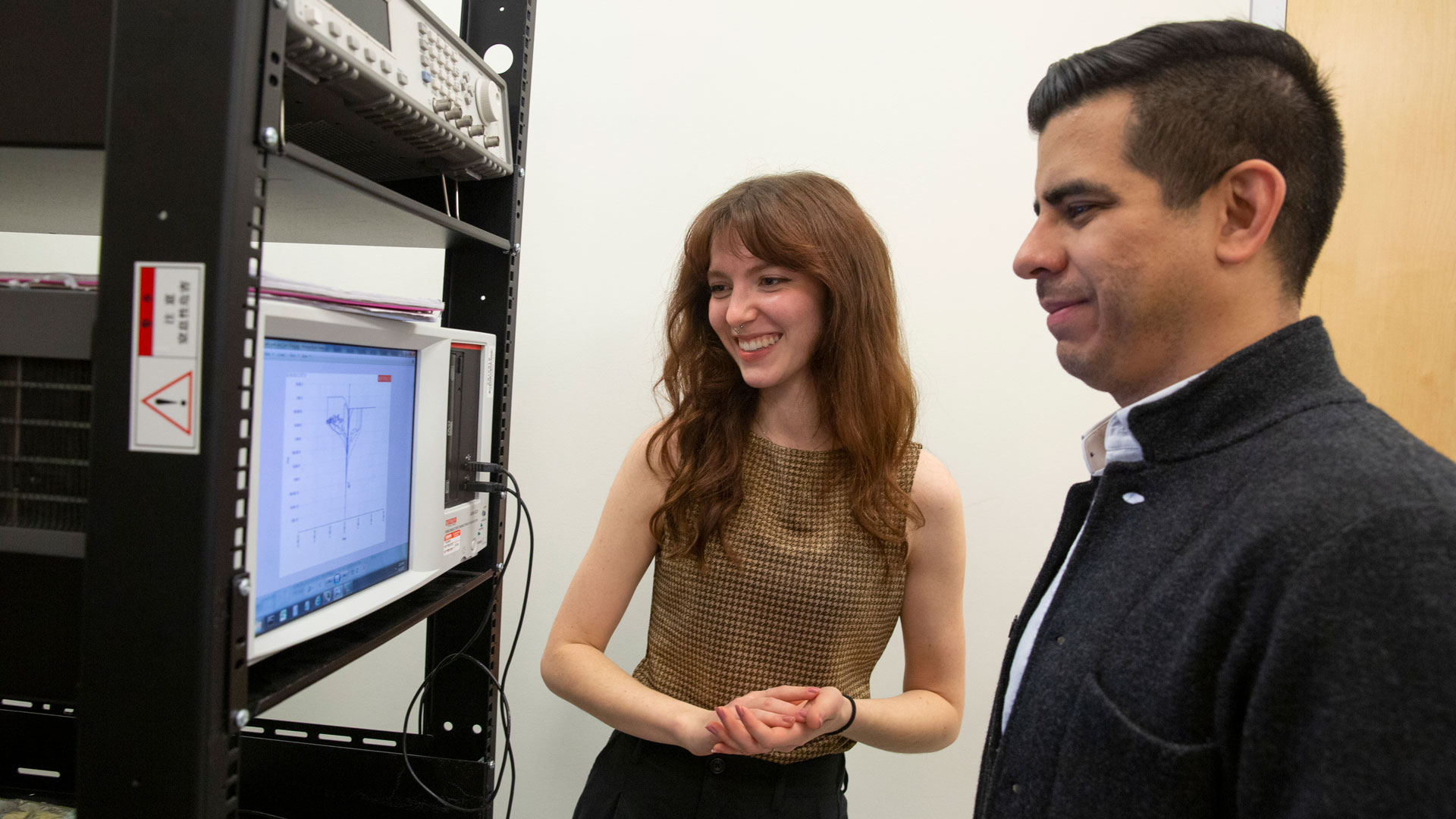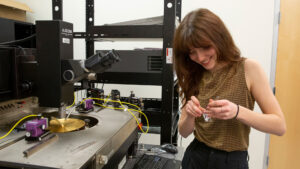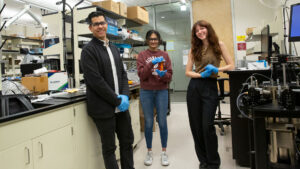Hailey Warner
Electrical engineering
Hometown: Mesa, Arizona, United States
Graduation date: Spring 2024
FURI | Spring 2023
Exploring the Physics of Resistive-Switching Behavior in Emerging Two-Dimensional Hexagonal Boron Nitride (2D h-BN) Memristors
The two-dimensional (2D) hexagonal boron nitride (h-BN) memristor is known to “switch” between high to low resistive states through the formation and erasure of conductive filaments between electrodes. Mechanisms behind this filament formation include both metallic diffusion (primarily acting in Ti/h-BN/Au memristors), as well as the forming of boron vacancies (primarily in Au/h-BN/Au memristors) in the h-BN layers when a voltage is swept across the device. To better comprehend how these processes govern “switching,” IV sweep characteristics of both the Ti/h-BN/Au and Au/h-BN/Au devices will be measured across various temperatures, carefully modeled, and ultimately compared.
Mentor: Ivan Sanchez Esqueda
Featured project | Spring 2023

Electrical engineering junior Hailey Warner is pursuing a FURI research project centered around the new semiconductor manufacturing research theme and sponsored by TSMC to explore the physics of memristor devices for neuromorphic or “brain-inspired” computing. Under the mentorship of Ivan Sanchez Esqueda, an assistant professor of electrical engineering, she is characterizing the switching behavior of 2D hexagonal boride nitride memristors, which could improve the efficiency and capabilities of machine learning hardware and neural networks.
What made you want to get involved in FURI and the project you’re working on?
I first discovered Dr. Ivan Sanchez Esqueda’s research in memristors via the FURI web page nearly two years ago. I became fascinated with this burgeoning field of neuromorphic computing and knew I wanted to one day participate in FURI for a chance to deepen my knowledge in a field beyond what classes could teach me.
After completing an electronic materials course and an internship at Intel, I reconnected with Dr. Sanchez Esqueda and he was very welcoming and excited to bring me into his lab.
How will your research project impact the world?
Neuromorphic computing revolutionizes how we view computer architecture by embedding memory within the processing unit, just like the human brain. The devices that make this possible? Memristors!
Think of memristors like a neuron. Not only can they store information, but when arranged together in certain ways, they can perform impressive computations with extreme haste and efficiency.
Memristors are an incredibly promising technology but they need to become more reliable. Through carefully testing and modeling these devices’ behavior, we can refine the manufacturing process and embed them in increasingly complex systems.
Did you have a particular “aha!” moment during your project?
My first “aha!” moment came when I observed a memristor in action at our lab’s probing station. When Mirembe Musisi-Nkambwe, Dr. Sanchez Esqueda’s very talented and helpful PhD student, first showed me a simple current and voltage test of the device, I suddenly grasped the concept of “switching” in memristors as we observed the resulting graph. Mirembe and I have had many more of these moments since!
Have there been any surprises in your research?
There are many physical processes that govern memristive switching, and learning about each one of them has come with its own intrigue. I have been surprised to see how slight changes in the memristor’s materials or structure can completely alter what is happening within the device on an atomic scale. This has easily been the most fascinating and rewarding aspect of the project.
How do you see this experience helping with your career or advanced degree goals?
Whether in industry R&D or academia, my goals have been set on research and scientific pursuit for quite a while. FURI exposes students to what this world is like. I hope to take both the technical, specific knowledge along with the soft skills I’ve acquired through FURI into graduate school and beyond.
What is the best advice you’ve gotten from your faculty mentor?
Dr. Ivan Sanchez Esqueda has given me extremely valuable insight into the process of publishing — how to craft an exceptional research paper, how to judge which results matter, how to communicate clearly and more. If not for his advice, I wouldn’t have known exactly how to narrow the focus of my project to something useful (and also possible!) within a semester. Both he and Mirembe Musisi-Nkambwe have always encouraged me to ask questions and have always answered them with enthusiasm. FURI would not be possible without their patient and diligent mentorship.
Why should other students get involved in FURI?
FURI is the perfect opportunity for students to participate in guided research and create real, meaningful results. It is also a great chance to work alongside field experts and glean valuable career advice. I would recommend FURI to any student who has a burning curiosity for a subject in their field or a technical problem they would like to explore in depth.
Sponsored project | Spring 2023
Hailey Warner’s FURI project is sponsored by TSMC.
TSMC is a global leader in the semiconductor foundry business. The company’s industry-leading process technologies and portfolio of design enablement solutions help its customers and partners unleash semiconductor innovation. With its recent expansion into Phoenix, TSMC sees the benefit of a strong partnership with ASU faculty and student researchers. TSMC supports the FURI program by providing additional funding for exceptional research projects related to the semiconductor industry. FURI student researchers who pursue a project related to the Semiconductor Manufacturing research theme are eligible for this sponsorship. TSMC-supported FURI students receive a $2,600 stipend and $400 to use for materials. Exceptional research proposals that align with the research theme of Semiconductor Manufacturing will be considered for this additional funding.


